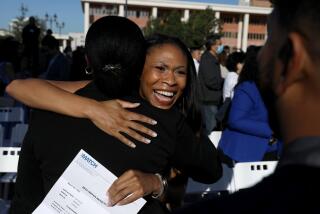The Surgeon
- Share via
DR. HILLEL LAKS’ day usually begins at 6:30 a.m. and doesn’t end until 9 p.m. or even midnight. Five days a week, UCLA Medical Center’s 45-year-old director of cardiothoracic surgery tends a full schedule of bypass and pediatric cardiac operations. And as chief heart transplant surgeon, the nights and weekends he would otherwise spend with his wife and three children are frequently taken with calls to do emergency transplants.
“I’ve seen him work 72 hours through,” says Dr. Lynne Warner Stevenson, medical director of UCLA’s heart transplant program. “Most people consider him superhuman in terms of his skills and his dedication to his patients.”
Laks, a native of South Africa, was finishing his medical internship in Johannesburg when Dr. Christiaan Barnard performed the first heart transplant, in Cape Town. Laks was attracted not only to the “technical challenge” of heart surgery but also to “a field where the effect of helping people is more dramatically seen.”
Laks left South Africa for the best cardiac surgery training then available, at Harvard and Boston’s Children’s Hospital. He later gained a reputation as one of the nation’s leading children’s heart surgeons and was director of pediatric cardiac surgery at Yale when UCLA recruited him in 1982. UCLA wanted a director who would expand its number of heart surgeries from 250 annually to 800. Laks saw a need for a transplant program in Southern California and proposed that the university start one.
The medical center’s first transplant was also Laks’. “The donor was not very good,” he acknowledges. That same day, when a second heart miraculously became available, “we had to do a second transplant.” That operation was a success, but the patient succumbed to an infection within a few months.
“It was a hard, difficult start,” Laks says. But it didn’t hinder the growth of the program or its establishment of an above-average success rate. Dr. Raymond Schultze, director of UCLA Medical Center, notes that Laks’ reputation as a surgeon “made getting referrals to the program much easier than if he’d been an unknown.” In 1985, Dr. Davis Drinkwater was hired to share a caseload that increases annually. In 1988, they expect to perform more than 40 transplants.
Laks doesn’t see a time soon when artificial hearts will replace the need for transplants. The human heart is “an incredible pump,” he says. “In terms of having no external power source, not forming clots within it, efficiency and wide range of function, it’s far superior to anything that has been thought of for an artificial heart.”
Nor would Laks want to replace the thousands of hours he has spent in its repair. “There’s nothing quite as satisfying as helping somebody and nothing quite as devastating as not being able to,” he says. “It makes for a life of great highs and great lows.”






